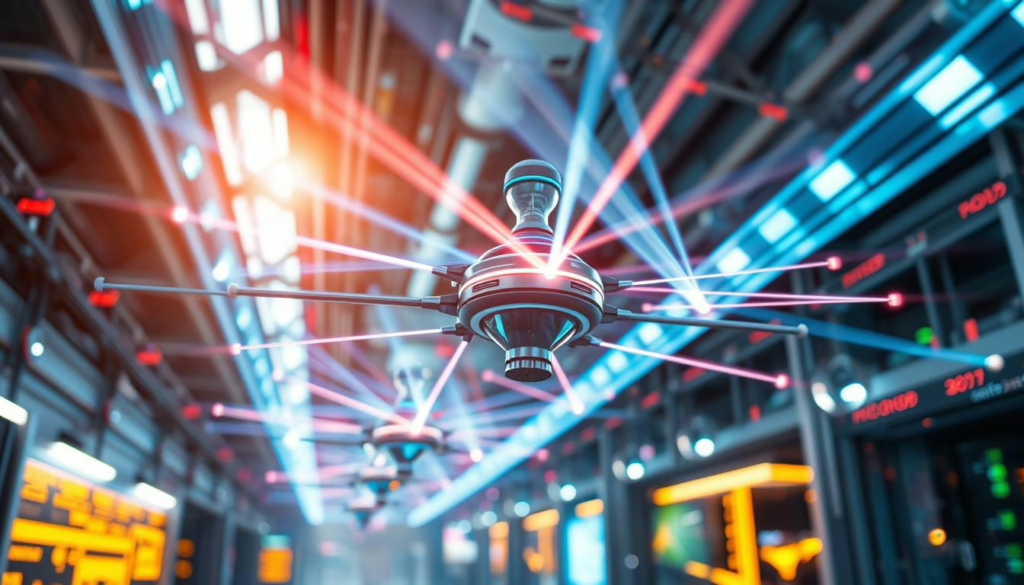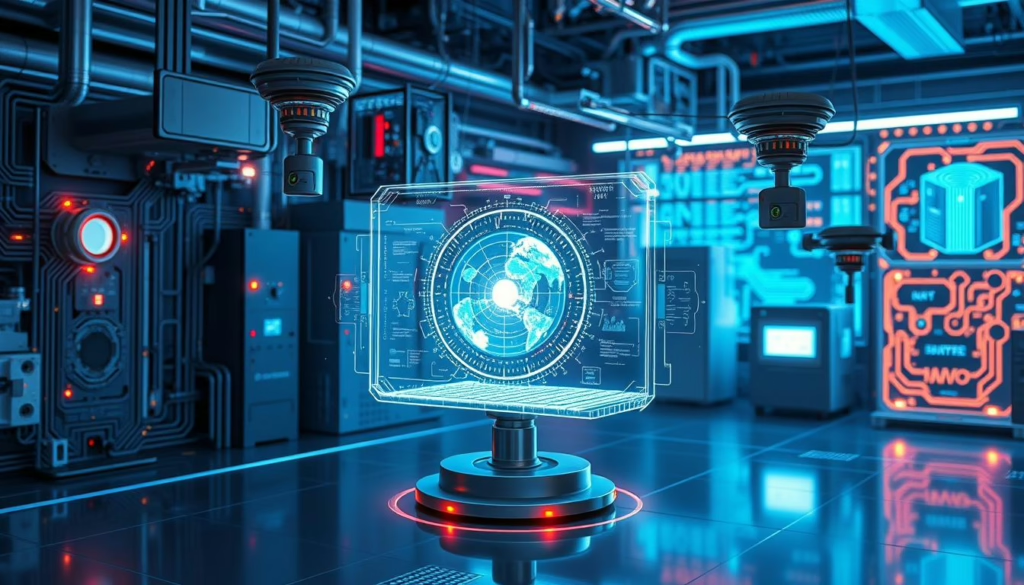Today, technology grows rapidly, and multi-directional sensing is at the forefront. These advanced sensors are changing how we understand space. They offer deep insights into our surroundings. Their growth has made them vital in many areas. These include self-driving cars, smart homes, and factories.
We’re going to look closer at these incredible sensors. We’ll see how they evolved and the new uses they offer. Most importantly, we’ll learn how they improve our interaction with the environment. This deep dive will show why they’re key to today’s innovations.

Key Takeaways
- Multi-directional sensing technology offers enhanced spatial awareness.
- These sensors are critical for obtaining accurate environmental insights.
- Advancements in sensing technologies have broadened their application scope.
- Integration into diverse fields like autonomous vehicles and smart homes.
- Continuous evolution promises even greater future potential.
Introduction to Multi-Directional Sensing
Multi-directional sensing is a game-changer in technology. It uses advanced sensors to capture data from all around at once. This means we can get more accurate and efficient information for various uses.
What is Multi-Directional Sensing?
This technology relies on many sensors working together. They collect data from different angles at the same time. Unlike old sensors that only saw one direction, multi-directional sensing gives a fuller picture. This makes the systems it’s part of work better.
Historical Background
The path of multi-directional sensing is full of key developments. At first, we only had sensors that could look one way. Now, technology has grown to watch multiple points at once. This growth came from the need for more detailed and trustworthy data in fields like aerospace, cars, and machines.
The Importance for Modern Technology
Today, multi-directional sensing is vital. It’s key for jobs needing quick, right-on data from many places. For example, cars use it to help drivers avoid crashes. And in factories, it makes machines run smoother and safer. Such tech helps in so many ways.
The Role of Sensor Fusion in Multi-Directional Sensing
Sensor fusion is crucial in multi-directional sensing. It combines data from various sensors for a fuller picture. This leads to better detection and accuracy in analyzing complex situations.
Defining Sensor Fusion
Sensor fusion means mixing data from different sensors into one output. It uses the strengths of each sensor and reduces their weaknesses. The aim is to improve detection and gain more accurate, comprehensive information.
Advantages of Combining Multiple Sensors
Combining multiple sensors has many benefits. Important ones include:
- Improved Accuracy: Mixing data from several sensors leads to fewer errors and more precise results.
- Enhanced Reliability: Having many sensors makes the system more dependable. It keeps working even if one sensor stops.
- Comprehensive Data: Data from many sensors gives a complete view, allowing for detailed analysis.
Sensor fusion is key for better detection in many fields, like self-driving cars and advanced security systems. It’s a vital part of today’s technology.
Advancements in IoT Devices for Multi-Directional Sensing
The world of technology is always changing. With multi-directional sensing, IoT devices have hit a big milestone. It’s not just a step forward but a whole new direction. This change brings great accuracy and efficiency. Smart technology in these devices opens up new chances for many fields.
Integration with IoT Systems
When multi-directional sensing joins IoT systems, things get better. This combo improves data gathering and analysis in real-time. By using smart tech, we get detailed data from all around. It gives a full view of the surroundings. This blend of tech keeps us in the lead for the future of sensing.
Real-World Applications
Fields like healthcare, agriculture, and manufacturing see big changes from this tech. In healthcare, it means sharper vital signs monitoring. For farming, it leads to better soil and crop info, boosting harvests. Manufacturing uses these sensors for better machine checks and upkeep. This shows the true power of smart technology.
| Industry | Application | Benefits |
|---|---|---|
| Healthcare | Patient Monitoring | Improved Vital Accuracy |
| Agriculture | Soil and Crop Analysis | Optimized Yield |
| Manufacturing | Machine Monitoring | Predictive Maintenance |
Future Potential
The possibilities for multi-directional sensing in IoT are vast. Innovation will bring even more uses. We look forward to systems that are more in tune and independent. This will change not just industries but how we live everyday. IoT devices with this sensing will lead the way in this shift.
Enhancing Environmental Monitoring with Multi-Directional Sensing
Multi-directional sensing technologies are a big step up in environmental monitoring. They provide much better data collection accuracy. This is key for keeping an eye on and reacting to changes in our environment. With these sensors, we collect more accurate data on air quality, water pollution, and other important environmental factors.
Improving Accuracy in Data Collection
Sensing technologies that work in many directions help us monitor the environment better. They gather large amounts of data from various views. This method improves data collection accuracy. So, we get a clearer and more precise picture of environmental changes. These sensors keep watch all the time. This means we spot issues and patterns as they happen. That allows for faster action to fix problems.
Practical Use Cases
Multi-directional sensing is used in many ways, such as:
- Checking air quality in cities to find pollutant levels and where they come from.
- Watching water bodies to spot contamination and make sure the water is safe.
- Looking at soil conditions on farms to improve the health and yield of crops.
- Forecasting weather patterns to help with climate studies and getting ready for disasters.
These examples show how important multi-directional sensing is for better environmental monitoring. With more accurate data collection and sensors everywhere, we can understand and protect our world better.
Impact of Artificial Intelligence on Multi-Directional Sensing
The combination of artificial intelligence and multi-directional sensing is changing how we analyze data and signals. These improvements mean our sensors are smarter and more adaptable. They offer new ways to monitor environments and spaces around us.
AI in Signal Processing
Artificial intelligence is key in boosting how we process signals. It uses machine learning to make signal interpretation more accurate and efficient. This helps sensors tell different signals apart, cutting down on noise and giving us clearer data.
Enhanced Data Analytics through AI
Artificial intelligence has transformed data analytics. It brings predictive analytics to sensing systems, allowing for real-time data use. Now, we can predict trends and behaviors quicker, giving us valuable insights when we need them.
Adaptive and Predictive Capabilities
The way AI-powered sensors adapt is incredible. They learn and adjust to new settings and changes. Predictive analytics make them even smarter, helping them foresee and tackle potential problems. This smartness and flexibility are creating new benchmarks in multi-directional sensing.
| Feature | Traditional Sensors | AI-Powered Sensors |
|---|---|---|
| Signal Processing Accuracy | Moderate | High |
| Data Analytics | Basic | Advanced |
| Predictive Capabilities | Limited | Robust |
| Adaptability | Fixed | Dynamic |
Innovations in Spatial Awareness Technologies
The world of spatial awareness tech has seen major upgrades. These changes impact many industries. They lead to better safety and navigation.
Key Developments
Latest advancements use complex sensing. These include advanced sensors in cars for real-time tracking. This is key for self-driving cars.
Robots are now more precise and safe, thanks to spatial technology. The aerospace field also gains, using it for accurate navigation.
Applications in Safety and Navigation
Spatial awareness is increasingly used for safety and navigating. Cars, for instance, use it to brake automatically before a crash.
In workplaces, it tracks equipment and people to prevent accidents. Navigation has also improved, helping in drone deliveries and logistics.
The Latest Hardware Developments
Hardware has greatly changed how sensors work. Now, sensors are tougher, use less power, and are more effective. These hardware improvements matter a lot. They help create strong sensing systems. These systems can handle different conditions and give back accurate information.
XJCSENSOR has been key in making these changes happen. They have made big steps forward, especially in the new energy field. By making sensor tech better, they have boosted how well things are made. They also made products last longer. Now, industries enjoy stronger sensing solutions. These are crucial for today’s manufacturing.
There have been big leaps in sensors for storing and making energy. These ensure devices like battery makers and coating machines work right. Investing in good hardware is vital. It keeps sensors working well in many directions. As we aim for more with sensor technology, these upgrades are key. They lead to smarter and greener solutions in many areas.
Data Analytics and Multi-Directional Sensing
Today’s tech world is constantly changing, which opens up new paths. With big data methods, we can make sense of huge amounts of sensor data. These insights lead to innovation.
The Role of Big Data
Big data is key for making the most of multi-directional sensing. It deals with the flood of data from many sensors. We need advanced tools to handle this data well.
- Volume: Handling extensive datasets generated by sensors.
- Velocity: Rapid processing speed to manage real-time data influx.
- Variety: Dealing with diverse data types from different sensor sources.
Transformative Analytics Techniques
New analytics methods are changing how we look at sensor data. With machine learning and AI, we find patterns and insights. This improves accuracy and predicts future trends.
| Technique | Application | Benefit |
|---|---|---|
| Machine Learning | Pattern Recognition in Sensor Data | Improved Predictive Accuracy |
| Statistical Analysis | Data Trend Analysis | Enhanced Decision Making |
| AI Algorithms | Automated Data Processing | Increased Efficiency |
These cutting-edge techniques bridge big data analytics and multi-directional sensing. They’re not just changing current data interpretation. They are also paving the way for the tech of tomorrow.
The Role of XJCSENSOR in Advancing Multi-Directional Sensing
At XJCSENSOR, we lead in multi-directional sensing technology. We’re always innovating and improving. Our work shines in many case studies. These studies show how our technology makes a big difference.
Our Contributions
We’ve greatly advanced multi-directional sensing. Our work boosts accuracy, efficiency, and versatility. By combining thorough research with new technologies, our sensors perform excellently.
This dedication leads to breakthroughs. These breakthroughs help many industries greatly.
- Accuracy: Improved precision in data collection.
- Efficiency: Increased sensor reliability and response times.
- Versatility: Adaptability to diverse applications and environments.
Case Studies
Our case studies show our sensing solutions at work. Here are examples where our technology made a real difference:
| Industry | Application | Impact |
|---|---|---|
| Automotive | Advanced Driver Assistance Systems (ADAS) | Enhanced safety and navigation capabilities. |
| Healthcare | Patient Monitoring Devices | Improved patient outcomes through accurate vitals tracking. |
| Industrial Automation | Robotic Process Automation (RPA) | Increased operational efficiency and reduced downtimes. |
These studies show our tech’s real-world impacts. We see better results in many fields.
Conclusion
We have seen amazing advancements in multi-directional sensing. These changes touch many parts of modern life. From the start, we’ve tracked the growth of sensor technology. It’s evolved through history, gotten smarter with the IoT, and improved with artificial intelligence. Sensors now work better and are more in tune with their surroundings. They hold great promise for the future.
The idea of sensor fusion brings big benefits. It combines different sensors for better data. This not only moves technology forward but also leads to major breakthroughs. It improves safety and navigation. The role of artificial intelligence is also huge. It makes data processing and predictions much better, adding value to sensor technology.
Looking ahead, the prospects for multi-directional sensing are bright. With ongoing developments in both hardware and software, and support from leaders like XJCSENSOR, this technology will shape our future. It will impact industries and how society works. As things change, it’s key to watch and use this technology. It will help us meet new challenges and find new opportunities.






